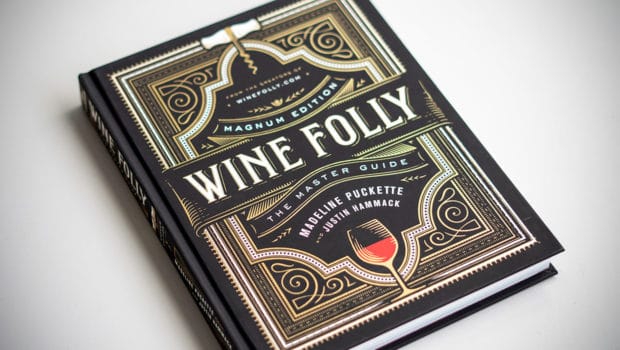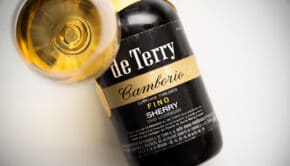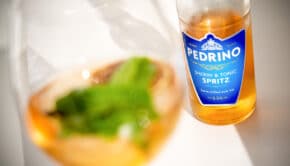8 things Wine Folly got wrong about sherry
I recently bought the new Wine Folly: Magnum Edition, a book about wine with a big focus on concise information. A lot of infographics help to simplify the matter. In fact it over-simplifies many topics. I was surprised to see sherry (a family of different styles) included in a chapter that lists grape varieties. Port and Madeira are also treated this way. That is problematic as sherry is essentially a denomination of origin rather than one specific wine. It uses different grapes and production methods to create a very wide array of styles and aromas.
Treating the sherry family as one wine will inevitably lead to generalization: characteristics can never apply to all individual styles. Writing about Palomino and PX as separate grapes would have been better, after all they are not exclusive to the sherry region.
Apart from this unfortunate conceptual choice, there are obvious factual errors in the book with regards to sherry. Quite a few even, considering there is basically just one page about sherry, plus a few paragraphs in related chapters about Spanish regions.
Wine Folly isn’t the only one having difficulty explaining sherry
It’s not my intention to point a finger at Wine Folly (only) here. As a graphic designer I really like what they are doing with infographics to make wine simpler. I definitely understand the need to leave out details. On the other hand even (I would say especially) succint information should be faultless, and in this case the errors could easily have been avoided.
As some of these misconceptions are rather widespread, I decided to dedicate an article to it.
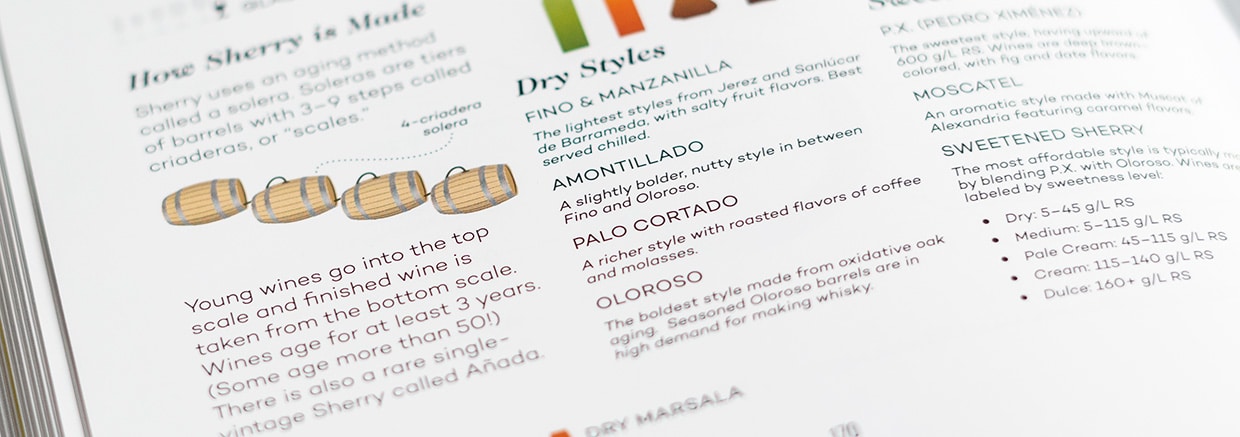
Wine Folly – Magnum Edition
1. Sherry is a dessert wine
Putting sherry in the dessert wine category (only) is confirming a widespread misconception. However it’s something that will annoy any sherry lover, given that the majority of sherry styles are dry. It is also these styles that are most appreciated by serious wine aficionados. Sherry works as a bone-dry aperitif (Fino or Manzanilla), with meat or cheese (Amontillado or Oloroso) and indeed some also work as a dessert wine (Moscatel and Pedro Ximénez).
Fino and Manzanilla have no oxidative ageing and no oak influence, so why don’t we see them as a white wine, albeit with a higher alcohol content? For Riesling they tick several categories of wines, so Sherry should have been listed for multiple categories, not only dessert wines. Having a fortified category would be a solution too.
2. Sherry wines age for at least 3 years
The official rules of the D.O. (the so-called Pliego de Condiciones article C.3.c) state that sherry should be aged for a minimum of two years. It used to be three years but this was changed in 2011.
3. When sherry is sweet, it’s blended with Pedro Ximénez
That’s true for Cream sherry, but 1. it doesn’t have to be PX (also Moscatel or rectified grape must can be used) and 2. not all sweet sherry is a blend. There are also naturally sweet sherries which are called after their grape variety: Pedro Ximénez and Moscatel. Lustau even has a sweet sherry made from Palomino Fino. They are naturally sweet because fermentation is halted early (either by additional fortification or because there’s simply too much sugar for the yeast to push through).
That gives us three major categories of sherry: dry, naturally sweet and blended sweet sherry. This isn’t clear in the book.
4. Sherry has an acidity of 4/5
Wine Folly gives a score of four out of five stripes for acidity, which is misleading as sherry has a low acidity level compared to other (white) wines. Especially Fino and Manzanilla have some of the lowest level of (volatile) acidity of all wines. The nature of Palomino grapes and the fact that they are picked late results in an average total acidity of 3.7 g/l and virtually no malic acid. In fact the pH in Palomino grape juice is troubling and often has to be corrected to avoid bacterial contamination.
Of course the total lack of sugars in dry sherry and the presence of acetaldehydes and minerals from the albariza soils will give it a fresh and bright appearance, which could be mistaken for acidity. However placing it at the same level as Verdejo for instance, and just one step behind Riesling is quite a stretch.
Again the problem is wild generalization. Wine Folly considering all sherry wines together, while there is a huge difference between a young Fino and a 30 year old, concentrated Oloroso.
5. Sherry should be served in a small dessert glass

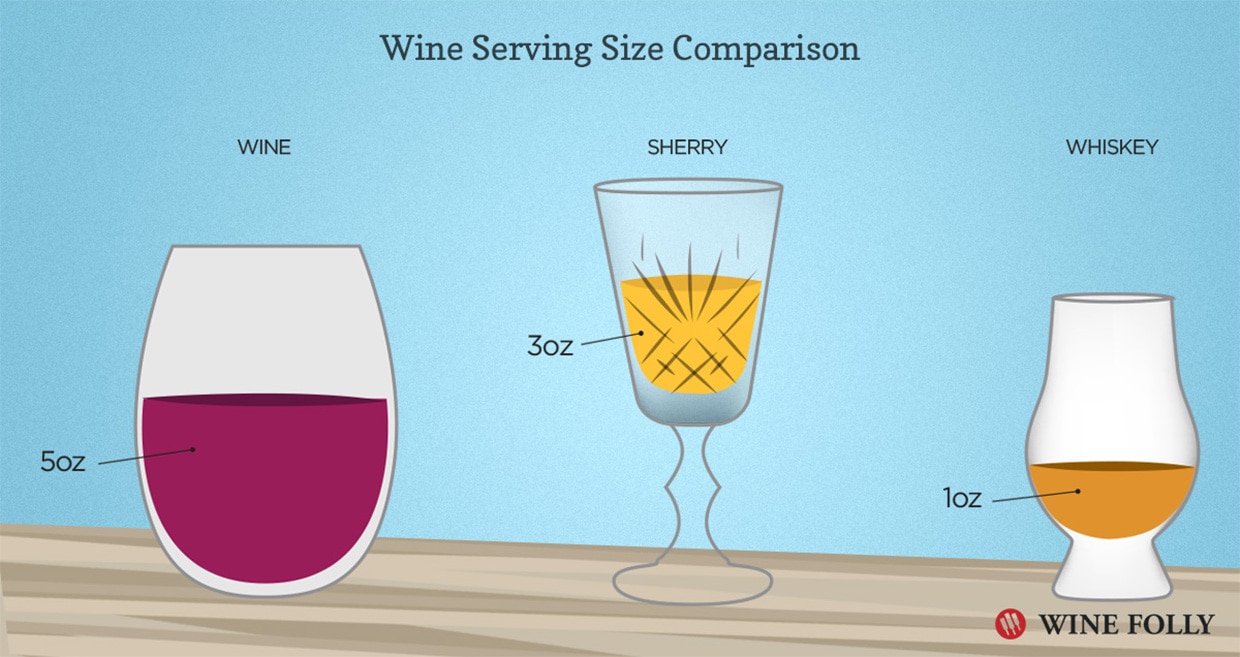
Granted, this comes from the website, not the book. But please don’t use this type of glass. (c) Wine Folly
6. PX sherry has upward of 600 g/l sugar
Pedro Ximénez sherry legally starts at 212 g/l of sugar. The majority of PX wines on the market contain around 300-400 grams per litre. I couldn’t find any PX that goes over 480g/l so it’s certainly not upward of 600. In fact this would probably give you an unfermentable grape juice to start with.
7. Amontillado is a nutty style in between Fino and Oloroso
I can live with this description because it’s true in terms of richness or aromatic intensity. However put putting it this way makes it seem like a continuum whereas Fino is related to Amontillado. Both have a different production method and aromatic profile than Oloroso though.
It would be better to simply define Amontillado as a further aged / oxidatively aged Fino in which the flor has died. In fact, it would also be nice to mention the crucial fact that Fino and Manzanilla are aged under flor, which isn’t the case (only as a side note on p.275 in the chapter about Spanish wine regions).
8. Sherry has a jackfruit aroma / flavour
I assume this is true. We don’t get jackfruit here in Europe, and I have little experience with it. It seems to contain some acetaldehydes (a chemical compound which also occurs naturally in coffee, bread, and ripe fruit), which is probably why it is mentioned here, but it’s the first time I’ve seen it as a descriptor for sherry wines. I think nutty aromas, a salty / savoury side and the typical acetaldehyde descriptors cut apple, almonds or chalk are more appropriate for Manzanilla and Fino and much more common for people to relate to.
More importantly: Amontillado, Oloroso, Moscatel and PX don’t have these pungent acetaldehydes, so again, it’s not a good idea trying to describe the aromas of sherry as a whole.
A stereotypical view on sherry
There are more remarks to be made. I see they mention Xerex – I assume this is just a typo, it should be Xérès (in French) or Jerez in Spanish. Also a solera system with four stages would be called a three-criadera system, not a four-criadera system. The last stage which holds the oldest wine is called the solera row and this isn’t counted as a criadera. Those are small remarks of course.
Assuming it is read by people studying wine, who may not have discovered proper sherry yet, the new Wine Folly Magnum Edition does little to disprove the sterotypical view of a sticky dessert wine that’s tippled from a substandard glass. Mixing characteristics of different types of sherries results in a vague and confusing description. The factual errors should be corrected, and a lot of things could be explained in a better way. I’m hoping for a revised edition!
Update: I’ve been in touch with the author. Some remarks made it to a list of errors and omissions (once published on the website, now gone). Other things are noted or simply set aside as nitpicking.


